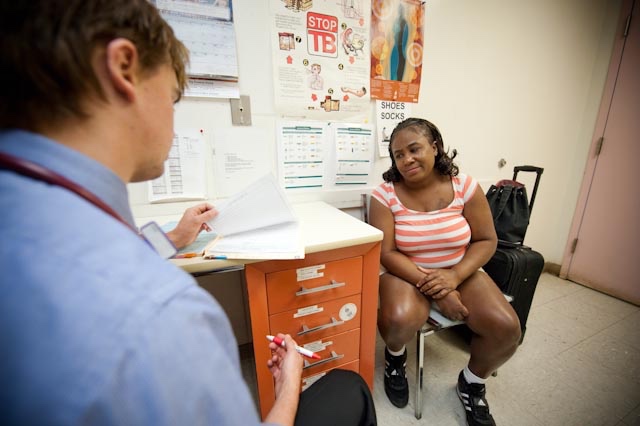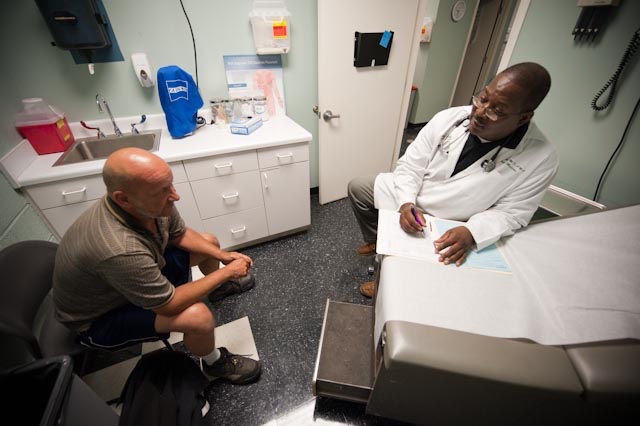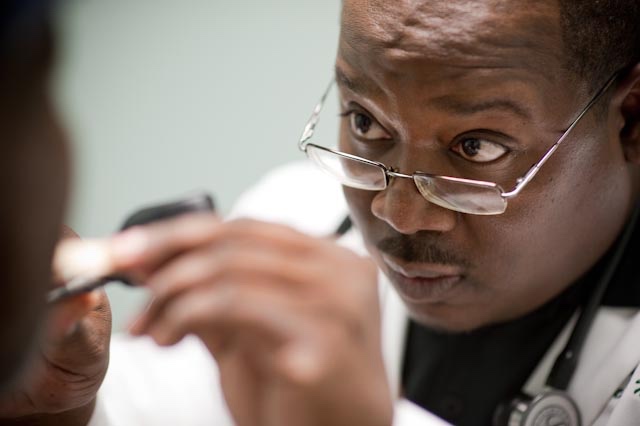
CAREY L BIRON, of Thomson Reuters Foundation, reports on the key role respite programs are playing in helping the homeless in the US during the coronavirus outbreak – and the “painful lessons” they’re confronting…
Washington DC, US
Thomson Reuters Foundation
Rahima Jackson was uninsured and living on the streets of Seattle in February when she was diagnosed with breast cancer — and the first cases of the novel coronavirus were reported in the area.
As she started chemotherapy in what soon became a US coronavirus hotspot, weekly treatments left her exhausted and vulnerable – yet she wasn’t considered sick enough to stay in a hospital.
Social workers “told me I’ll be in a place to rest while I take my treatment,” Jackson, 60, told the Thomson Reuters Foundation by phone from a room at the Edward Thomas House, a medical respite program in Seattle.

A homeless patient consults with medical personnel at a clinic in Nashville, Tennessee, in 2010. PICTURE: Handout photo by National Health Care for the Homeless Council.
Also known as recuperative care, respite programs offer temporary, in-between care for homeless patients who are too sick to be on the street or in a shelter but not sick enough to be admitted to a hospital.
They have nearly doubled in number since 2012, according to the National Health Care for the Homeless Council, an NGO, with at least 110 today and a dozen more in development.
“The outbreak has the potential to make a strong case for expanded respite services because there is broader awareness of what we do, even on a state level.”
– Leslie Enzian, medical director at the Edward Thomas House.
As the coronavirus pandemic has spread across the United States, which has the world’s largest number of confirmed cases, little-known respite programs have filled a key role.
Some are training other medical personnel on their unique skills, while the programs are receiving increased recognition from policymakers and other parts of the health sector, advocates say.
“The outbreak has the potential to make a strong case for expanded respite services because there is broader awareness of what we do, even on a state level,” said Leslie Enzian, medical director at the Edward Thomas House.
For Jackson, who had not previously heard of respite, the program felt like a lifesaver.
“When I came up here, everything changed. You’re relaxing…[in a way] you never thought you’d see when you’re out there on the street,” she said.
She said that she will stay in respite for three months, after which social workers are aiming to find her an apartment of her own.
Jackson has tested negative for COVID-19, the disease caused by the coronavirus, but said she remains worried about contracting it.
Without respite, she said, “I would be dead by now.”

A homeless patient consults with medical personnel at a clinic in Nashville, Tennessee, in 2010. PICTURE: Handout photo by National Health Care for the Homeless Council
Even the largest respite programs have had their operations turned upside-down by the coronavirus, said program directors across the country.
“Ninety per cent of our focus has been on the COVID-related stuff,” said David Munson, medical director of respite programs for the Boston Health Care for the Homeless Program, one of the country’s oldest and largest.
His staff is also providing clinical care at a large city-operated field hospital set up in response to the virus.
But there are limits to what respite can do.
For the most part, respite is not federally funded, and most programs remain small, with fewer than 20 beds, said Julia Dobbins, a project manager with the NHCHC.
A spokesman for the US Department of Health and Human Services said it supports the NHCHC and referred the Thomson Reuters Foundation to the council for questions.
“This virus has taken a while to show up in the homeless community, but it really is a ticking time bomb: such a vulnerable group of people with so many underlying conditions.”
– Julia Dobbins, a project manager with the NHCHC.
The outbreak has offered “painful lessons”, Dobbins said: “We’re in a situation now where we’re looking at our community and saying, why don’t we have more of these programs? These would have been so helpful right now.”
Those that do exist now need to figure out how to balance the needs of vulnerable current patients alongside those of a potential influx of possible or confirmed coronavirus cases, Dobbins and others said.
Some respite programs, as in Seattle and Boston, are taking in patients who are COVID-19 positive, or even focusing solely on such patients.
Others are not, instead admitting extra non-positive patients to free up space in hospitals or shelters, Dobbins said.
“This virus has taken a while to show up in the homeless community, but it really is a ticking time bomb: such a vulnerable group of people with so many underlying conditions,” Dobbins said.
“There is this fear that as soon as it starts showing up, we’re already behind it.”
Testing at 19 homeless shelters in four cities found average coronavirus infection rates of 25 per cent — and as high as two-thirds in San Francisco, according to a Centers for Disease Control and Prevention report last week.

A doctor examines a homeless patient at a clinic in Nashville, Tennessee, in 2010. PICTURE: Handout photo by National Health Care for the Homeless Council
Still, what should be done with coronavirus-positive patients who have no home to quarantine or recuperate in has remained a complicated question.
The primary response among local health departments has been to repurpose unused motels, said Dobbins.
But “the staffing of those is really dependent on who is working in those areas…[including] engaging a volunteer workforce, and some have never worked with people with severe trauma,” she said.
Respite programs are adept at diagnosing and dealing simultaneously with addiction, mental-health concerns and potential violent episodes in addition to pressing medical problems, Dobbins and others said.
Amid the coronavirus response, she pointed to examples of homeless people being thrown out of motel programs for addiction problems, for instance – or simply being unable to deal with the isolation of quarantine measures.
In response, some are increasingly looking to respite programs on planning and assistance.
In Seattle, for instance, staff members from the Edward Thomas House are training nurses at a new COVID-19 shelter for homeless patients who have tested positive or are awaiting results.
Program manager Melissa Brown said staff have also mounted a tent and sleeping bag drive for respite patients who are to be discharged but are too afraid to go back into the shelter system.
Other respite programs are not discharging patients at all.
“We knew there was a surge coming, and we needed to be able to get people out of the hospital,” said Sara Jeevanjee, medical director at the Santa Clara Medical Respite Program, in Northern California.
“So we started thinking about how to expand our program because we weren’t going to be able to discharge anyone. Once in the motel room, they need to stay in that motel room,” she said.
The respite is now in a new building with 65 beds – more than three times its previous capacity, and is in the process of tripling its staff.
Helen Waugh is a patient at the program. A live-in caregiver, the 71-year-old could not continue her job when she recently started treatment for recurring cancer – and thus lost her home, at least temporarily.
But she is full of praise for her respite experience: “Every day I get tested. Meals are delivered by the door, and we just pick up the bag and eat. Any attention we need is given right away.”
The only point of concern is the program’s size, she said, noting “they don’t have enough room to shelter all of the homeless and sick people”.
“Particularly with the virus now, I think they’d have thousands of people here.”





